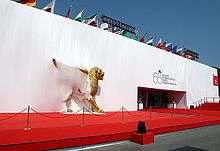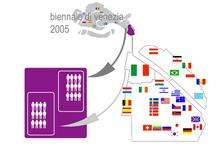Biennale
Biennale (pronounced [bi.enˈnaːle]), Italian for "biennial" or "every other year", is any event that happens every two years. It is most commonly used within the art world to describe large-scale international contemporary art exhibitions. As such the term was popularised by Venice Biennale, which was first held in 1895. The phrase has since been used for other artistic events, such as the "Biennale de Paris", "Kochi-Muziris Biennale", or even as a portmanteau as with Berlinale (for the Berlin International Film Festival) and Viennale (for Vienna's international film festival). "Biennale" is therefore used as a general term for other recurrent international events (such as triennials, Documenta, Skulptur Projekte Münster).

Characteristics
According to author Federica Martini, what is at stake in contemporary biennales is the diplomatic/international relations potential as well as urban regeneration plans. Besides being mainly focused on the present (the “here and now” where the cultural event takes place and their effect of "spectacularisation of the everyday"), because of their site-specificity cultural events may refer back to, produce or frame the history of the site and communities' collective memory.[1]

A strong and influent symbol of biennales and of large-scale international exhibitions in general is the Crystal Palace, the gigantic and futuristic London architecture that hosted the Great Exhibition in 1851. According to philosopher Peter Sloterdijk,[2] the Crystal Palace is the first attempt to condense the representation of the world in a unitary exhibition space, where the main exhibit is society itself in an a-historical, spectacular condition. The Crystal Palace main motives were the affirmation of British economic and national leadership and the creation of moments of spectacle. In this respect, 19th century World fairs provided a visual crystallization of colonial culture and were, at the same time, forerunners of contemporary theme parks.
The Venice Biennale as an archetype

The Venice Biennale, a periodical large-scale cultural event founded in 1895, served as an archetype of the biennales. Meant to become a World Fair focused on contemporary art, the Venice Biennale used as a pretext the wedding anniversary of the Italian king and followed up to several national exhibitions organised after Italy unification in 1861. The Biennale immediately put forth issues of city marketing, cultural tourism and urban regeneration, as it was meant to reposition Venice on the international cultural map after the crisis due to the end of the Grand Tour model and the weakening of the Venetian school of painting. Furthermore, the Gardens where the Biennale takes place were an abandoned city area that needed to be re-functionalised. In cultural terms, the Biennale was meant to provide on a biennial basis a platform for discussing contemporary art practices that were not represented in fine arts museums at the time. The early Biennale model already included some key points that are still constitutive of large-scale international art exhibitions today: a mix of city marketing, internationalism, gentrification issues and destination culture, and the spectacular, large scale of the event.
Biennials after the 1990s
The situation of biennials has changed in the contemporary context: while at its origin in 1895 Venice was a unique cultural event, but since the 1990s hundreds of biennials have been organized across the globe. Given the ephemeral and irregular nature of some biennials, there is little consensus on the exact number of biennials in existence at any given time. Furthermore, while Venice was a unique agent in the presentation of contemporary art, since the 1960s several museums devoted to contemporary art are exhibiting the contemporary scene on a regular basis. Another point of difference concerns 19th century internationalism in the arts, that was brought into question by post-colonial debates and criticism of the contemporary art “ethnic marketing”, and also challenged the Venetian and World Fair’s national representation system. As a consequence of this, Eurocentric tendency to implode the whole word in an exhibition space, which characterises both the Crystal Palace and the Venice Biennale, is affected by the expansion of the artistic geographical map to scenes traditionally considered as marginal. The birth of the Havana Biennial in 1984 is widely considered an important counterpoint to the Venetian model for its prioritization of artists working in the Global South and curatorial rejection of the national pavilion model.
International biennales
In the term's most commonly used context of major recurrent art exhibitions:
- Adelaide Biennial of Australian Art, South Australia
- Asian Art Biennale, in Taichung, Taiwan (National Taiwan Museum of Fine Arts)
- Athens Biennale, in Athens, Greece
- Bienal de Arte Paiz, in Guatemala City, Guatemala[3]
- Arts in Marrakech (AiM) International Biennale (Arts in Marrakech Festival)
- Bamako Encounters, a biennale of photography in Mali
- Bat-Yam International Biennale of Landscape Urbanism
- Beijing Biennale
- Berlin Biennale (contemporary art biennale, to be distinguished from Berlinale, which is a film festival)
- Bi-City Biennale of Urbanism\Architecture, in Shenzhen and Hong Kong, China
- Bienal de Arte de Ponce in Ponce, Puerto Rico
- BiennaleOnline Online biennial exhibition of contemporary art from the most promising emerging artists.
- Biennial of Hawaii Artists
- Biennale de la Biche, the smallest biennale in the world held at deserted island near Guadeloupe, French overseas region[4][5]
- La Biennale de Montreal
- Bucharest Biennale in Bucharest, Romania
- Bushwick Biennial, in Bushwick, Brooklyn, New York
- Canakkale Biennial, in Canakkale, Turkey
- Cerveira International Art Biennial, Vila Nova de Cerveira, Portugal [6]
- Copenhagen Ultracontemporary Biennale, biennale in Copenhagen, Denmark
- Dakar Biennale, also called Dak'Art, biennale in Dakar, Senegal
- Estuaire (biennale), biennale in Nantes and Saint-Nazaire, France
- EVA International, biennial in Limerick, Republic of Ireland
- Göteborg International Biennial for Contemporary Art, in Gothenburg, Sweden[7]
- Greater Taipei Contemporary Art Biennial, in Taipei, Taiwan
- Gwangju Biennale, Asia's first and most prestigious contemporary art biennale
- Havana biennial, in Havana, Cuba
- Herzliya Biennial For Contemporary Art, in Herzliya, Israel
- Incheon Women Artists' Biennale, in Incheon, South Korea
- Iowa Biennial, in Iowa, USA
- Istanbul Biennial, in Istanbul, Turkey
- International Roaming Biennial of Tehran, in Tehran and Istanbul
- Jakarta Biennale in Jakarta, Indonesia www.jakartabiennale.net
- Jerusalem Biennale in Jerusalem, Israel
- Jogja Biennale, in Yogyakarta, Indonesia www.biennalejogja.org
- Karachi Biennale, in Karachi, Pakistan
- Keelung Harbor Biennale, in Keelung, Taiwan
- Kochi-Muziris Biennale, largest art exhibition in India, in Kochi, Kerala, India
- Kortrijk Design Biennale Interieur, in Kortrijk, Belgium
- Kobe Biennale, in Japan kobe-biennale.jp/_en/
- Kuandu Biennale, in Taipei, Taiwan
- Light Art Biennale Austria, in Austria
- Liverpool Biennial, Liverpool, UK
- Manifesta, European Biennale of contemporary art in different European cities
- Mediations Biennale, in Poznań, Poland
- Melbourne International Biennial 1999
- Mediterranean Biennale in Sakhnin 2013
- MOMENTUM, in Moss, Norway[8]
- Moscow Biennale, in Moscow, Russia
- Munich Biennale, new opera and music-theatre in even-numbered years
- Mykonos Biennale
- Nakanojo Biennale[9]
- October Salon (Serbian: Oktobarski salon), organised by the Cultural Center of Belgrade, in Belgrade, Serbia[10]
- OSTEN Biennial of Drawing Skopje, North Macedonia[11]
- Biennale de Paris
- Riga International Biennial of Contemporary Art (RIBOCA), in Riga, Latvia[12]
- São Paulo Art Biennial, in São Paulo, Brazil
- SCAPE Public Art Christchurch Biennial in Christchurch, New Zealand[13]
- Prospect New Orleans
- Seoul Biennale of Architecture and Urbanism
- Shanghai Biennale
- Sharjah Biennale, in Sharjah, UAE
- Singapore Biennale, held in various locations across the city-state island of Singapore
- Screen City Biennial in Stavanger, Norway
- Biennale of Sydney
- Taipei Biennale, in Taipei, Taiwan
- Taiwan Arts Biennale, in Taichung, Taiwan (National Taiwan Museum of Fine Arts)
- Taiwan Film Biennale, in Hammer Museum, Los Angeles, U.S.A.
- Dream city, produced by ART Rue Association in Tunisia
- Vancouver Biennale
- Venice Biennale, in Venice, Italy, which includes:
- Venice Biennale of Contemporary Art
- Venice Biennale of Architecture
- Venice Film Festival
- Vladivostok biennale of Visual Arts, in Vladivostok, Russia
- Whitney Biennial, hosted by the Whitney Museum of American Art, in New York City, NY, USA
- Web Biennial, produced with teams from Athens, Berlin and Istanbul.
- WRO Biennale, in Wrocław, Poland[14]
- Music Biennale Zagreb
- [SHIFT:ibpcpa] The International Biennale of Performance, Collaborative and Participatory Arts, Nomadic, International, Scotland, UK.
See also
- World's fair
- Art exhibition
- Art festival
- Art biennials in Africa
References
- Vittoria Martini e Federica Martini, Just another exhibition. Histories and politics of biennials, Postmedia Books, 2011 ISBN 8874900600, ISBN 978-8874900602.
- Im Weltinnenraum des Kapitals, 2005.
- "In Guatemala, the Bienal de Arte Paiz Offers an Object Lesson in Community-Based Art Done Right". artnet News. 2018-09-07. Retrieved 2020-08-03.
- https://artreview.com/news/news_24_jan_2017_worlds_smallest_biennial_on_ilet_la_biche/
- "Welcome to the world's smallest art fair – on a disappearing speck of sand". the Guardian. January 24, 2017.
- "Bienal de Cerveira". Bienal de Cerveira.
- "GIBCA • home". www.gibca.se.
- "Momentum (Norway)". Biennial Foundation. Retrieved 2020-08-02.
- "ENGLISH|NAKANOJO BIENNALE". June 12, 2013.
- "October Salon (Serbia)". Biennial Foundation. Retrieved 2020-08-02.
- Gallery, Osten. "Drawing". osten.mk.
- "RIBOCA - Riga International Biennial of Contemporary Art (Latvia)". Biennial Foundation. Retrieved 2020-08-03.
- "Scape Public Art". Retrieved July 7, 2016.
- "Biennale WRO". WRO ART CENTER. November 24, 2009.
Further reading
- Filipovic, Elena (2010). Marieke van Hal, Solveig Øvsteø (ed.). The Biennial Reader. Bergen, Norway: Bergen Biennial Conference.
- Jones, Caroline (2006-03-29). "Biennial Culture". Institute national d’histoire de l’art, Paris. Cite journal requires
|journal=(help) - (in English and Italian) Vittoria Martini e Federica Martini, Just another exhibition. Histories and politics of biennials, Postmedia Books, 2011 ISBN 8874900600, ISBN 978-8874900602
- Federica Martini, Cultural event in Mobile A2K Methodology guide, 2002.
- Manifesta Journal No 2 Winter 2003/ Spring 2004 - Biennials. Artimo Foundation. 1 June 2003. ISBN 907538095X.
- Morris, Jane (May 1, 2019). "Why is the Venice Biennale still so important?". The Art Newspaper. Retrieved May 4, 2019.
- Vanderlinden, Barbara (2 June 2006). Elena Filipovic (ed.). The Manifesta Decade: Debates on Contemporary Art Exhibitions and Biennials in Post-Wall Europe (illustrated ed.). The MIT Press. ISBN 0262220768.
External links
- Biennial Foundation
- "Global Exhibitions: Contemporary Art and the African Diaspora". Liverpool. 2010-02-19. Cite journal requires
|journal=(help) - Byrne, John (2005). "Contemporary Art and Globalisation: Biennials and the Emergence of the De-Centred Artist". Cambridge: University of Cambridge. Archived from the original on 2007-09-01. Retrieved 2013-06-05. Cite journal requires
|journal=(help)